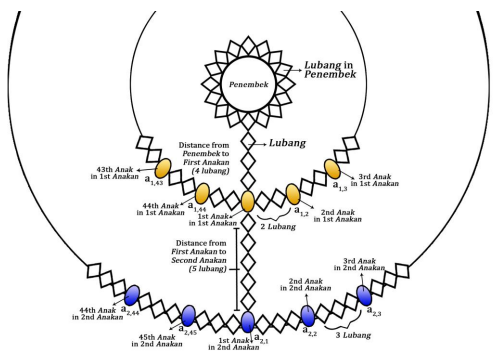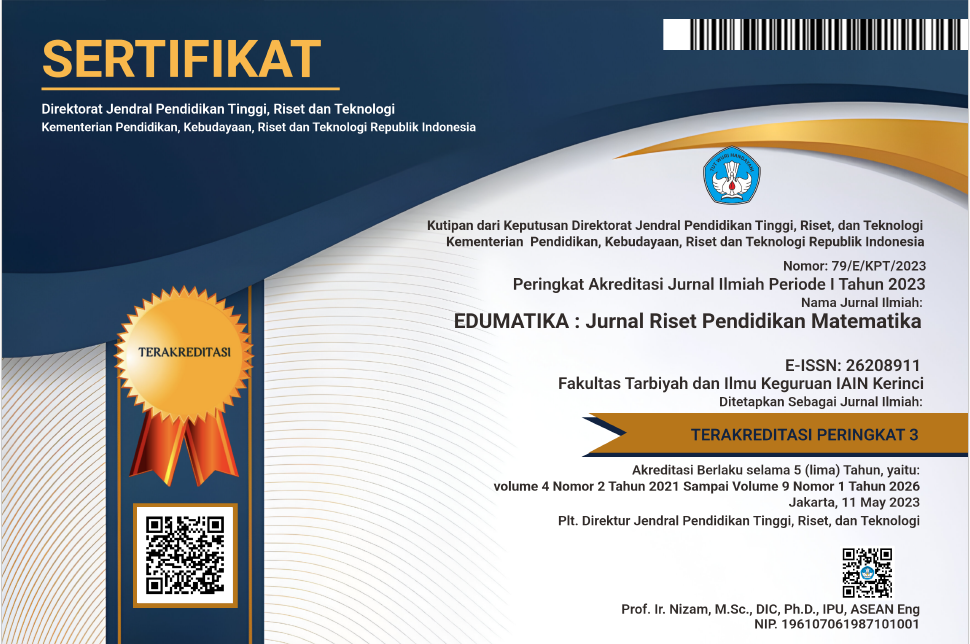The Arithmetic Sequences in Making Traditional Cast Nets in Lombok
Abstract
Mathematical concepts can be found in the culture of the community, such as in daily activities and handicrafts. One type of handicraft is the pencar, a cast net (throw net) fishermen use to catch fish. This research aims to explore the arithmetic sequences involved in making a pencar. This research uses qualitative research with ethnography. The research was conducted in Marong Village, West Nusa Tenggara, Indonesia. Data were obtained by direct observation of the pencar and the process of making it, interviews with cast-net handycrafters, and literature studies on arithmetic sequences. The results of this study show that there are three arithmetic sequences in the pencar. The first sequence, the number of anak (meshes) between each anakan (widener) in the n-th widener row, is 3, 4, 5, and so on, formulated by Un = 3 + (n - 1). The second sequence, the number of anakan (widener) in the n-th widener row is 44, 45, 46, and so on, formulated by Un = 44 + (n - 1). The third sequence, the number of lubang (meshes) in the n-th anakan is 44, 90, 138, 188, and so on, formulated by Un = n^2 + 43n. The arithmetic sequences in pencar can be used as a problem context for culture-based learning in the arithmetic sequence topic.
Downloads
References
Alghar, M. Z., & Marhayati. (2023). Ethnomathematics: Exploration of Fractal Geometry in Gate Ornaments of the Sumenep Jamik Mosque Using the Lindenmayer System. Indonesian Journal of Science and Mathematics Education, 6(3), 311–329. https://doi.org/10.24042/ijsme.v6i3.18219
Alghar, M. Z., Susanti, E., & Marhayati. (2022). Ethnomathematics: Arithmetic Sequence Patterns of Minangkabau Carving on Singok Gonjong. Jurnal Pendidikan Matematika (Jupitek), 5(2), 145–152. https://doi.org/10.30598/jupitekvol5iss2pp145-152
Alghar, M. Z., Walidah, N. Z., & Marhayati. (2023). Ethnomathematics: The exploration of fractal geometry in Tian Ti Pagoda using the Lindenmayer system. Alifmatika: Jurnal Pendidikan dan Pembelajaran Matematika, 5(1), 57–69. https://doi.org/10.35316/alifmatika.2023.v5i1.57-69
Ami, R. (2021). Etnomatematika Pada Kebiasaan Orang Sunda Dalam Menentukan Tanggal Pernikahan Dan Kecocokan Pasangan Pengantin. Jurnal PEKA, 4(2). https://doi.org/10.37150/jp.v4i2.842
Azrida, Y., Mashadi, M., & Gemawati, S. (2015). Menentukan Suku Ke-n Barisan Bertingkat. Jurnal Karismatika, 1(2), 45–53. https://doi.org/10.24114/jmk.v1i2.17066
Bartle, R. G., & Sherbert, D. R. (2000). Introduction to real analysis (2 ed.). Wiley.
Bird, J. (2020). Arithmetic and geometric progressions (8 ed.). Routledge Publishing. https://doi.org/10.4324/9780080962122-5
Budiyanti, D., Iskandar, J., & Partasasmita, R. (2018). Pengetahuan lokal nelayan tradisional Pangandaran, Jawa Barat, Indonesia tentang cara penangkapan ikan dengan jaring arad, jenis-jenis ikan yang ditangkap, dan penentuan musim penangkapan ikan. Jurnal Masyarakat Biodiv Indonesia, 4(2), 115–121. https://doi.org/10.13057/psnmbi/m040204
d’Ambrosio, U. (2001). In My Opinion: What Is Ethnomathematics, and How Can It Help Children in Schools? National Council of Teachers of Mathematics (NCTM), 7(6), 308–310. https://doi.org/10.5951/tcm.7.6.0308
Delviana, R., & Putra, A. (2022). Systematic Literature Review: Eksplorasi Etnomatematika pada Ornamen. Leibniz: Jurnal Matematika, 2(1), 48-58. https://doi.org/10.59632/leibniz.v2i1.143
Indrahti, S., & Maziyah, S. (2021). Identification of Fishing Gear in Java from Historical and Cultural Perspective. Journal of Maritime Studies and National Integration, 5(1), 30–41. https://doi.org/10.14710/jmsni.v5i1.11182
Kholis, M. N., Amrullah, M. Y., & Limbong, I. (2021). Studi Jenis Alat Penangkapan Ikan Tradisional di Sungai Batang Bungo Kabupaten Bungo Provinsi Jambi. Jurnal Sumberdaya Akuatik Indopasifik, 5(1), 31–46. https://doi.org/10.46252/jsai-fpik-unipa.2021.Vol.5.No.1.107
Kou, D., & Deda, Y. N. (2020). Eksplorasi etnomatematika acara adat Thelas Keta pada masyarakat Noemuti. Range: Jurnal Pendidikan Matematika, 2(1), 1–7. https://doi.org/10.32938/jpm.v2i1.468
Latuconsina, H. (2010). Identifikasi alat penangkapan ikan ramah lingkungan di kawasan konservasi laut Pulau Pombo Provinsi Maluku. Agrikan: Jurnal Agribisnis Perikanan, 3(2), 23–30. https://doi.org/10.29239/j.agrikan.3.2.23-30
Malalina, M., Putri, R. I. I., Zulkardi, Z., & Hartono, Y. (2020). Ethnomathematics of fish catching exploration in Musi River. In M. Muhtarom, R. C. I. Prahmana, F. Nursyahidah, & N. Happy (Ed.), The 5th Seminar Nasional Matematika dan Pendidikan Matematika (SENATIK) 2020 (Vol. 1663, Nomor 1, pp. 1–7). IOP Publishing. https://doi.org/10.1088/1742-6596/1663/1/012007
Mardhiyah, B., Abbas, E. W., Mutiani, M., Syaharuddin, S., & Subiyakto, B. (2022). Traditional Fishing Tools for Banjar People. The Kalimantan Social Studies Journal, 4(1), 1–8. https://doi.org/10.20527/kss
Muzdalipah, I., & Yulianto, E. (2018). Ethnomathematics study: The technique of counting fish seeds (Osphronemus gouramy) of sundanese style. Journal Of Medives: Journal Of Mathematics Education IKIP Veteran Semarang, 2(1), 25–40. https://doi.org/10.31331/medives.v2i1.555
Nandang, N., Koriah, T., & Mellawaty, M. (2021). Eksplorasi Etnomatematika Pada Proses Kerajinan Tangan Bros Kain Susun Masyarakat Desa Cantigi Kulon Kecamatan Cantigi Indramayu. In D. Ismunandar (Ed.), Prosiding Seminar Nasional Matematika dan Sains (Vol. 3, Nomor 1, pp. 298–307). Universitas Wiralodra.
Nurfauziah, N., & Putra, A. (2022). Systematic Literature Review: Etnomatematika pada Rumah Adat. Jurnal Riset Pembelajaran Matematika, 4(1), 5-12. https://doi.org/10.55719/jrpm.v4i1.351
Nurjamil, D., Muhtadi, D., & Habibah, A. (2021). Studi Etnomatematika: Mengungkap Konsep Matematika pada Kerajinan Anyaman Bambu di Kecamatan Cigalontang Kabupaten Tasikmalaya. Didactical Mathematics, 3(1), 64–81. https://doi.org/10.31949/dm.v3i1.1444
Orey, D. C., & Rosa, M. (2015). Modelling the wall: The mathematics of the curves on the wall of Colégio Arquidiocesano in Ouro Preto. In G. A. Stillman, W. Blum, & M. S. Biembengut (Ed.), Mathematical Modelling in Education Research and Practice (1 ed., pp. 593–603). Springer. https://doi.org/10.1007/978-3-319-18272-8_50
Purnawan, H., & Subiono, S. (2022). Barisan Aritmatika Bertingkat dengan Menggunakan Interpolasi Lagrange. Limits: Journal of Mathematics and Its Applications, 19(2), 145–154. https://doi.org/10.12962/limits.v19i2.8298
Radjak, D. S., Susanti, E., & Marhayati, M. (2022). Eksplorasi Konsep Matematika Pada Gapura Monumen Trikora di Lembeh Sulawesi Utara. In A. Abdussakir, M. Jamhuri, & J. Juhari (Ed.), Prosiding SIMaNIs (Seminar Nasional Integrasi Matematika dan Nilai-Nilai Islam) (pp. 95–105).
Rahmani-Andebili, M. (2021). Precalculus Practice Problem, Methods, and Solutions. In Precalculus (1 ed.). Springer. https://doi.org/10.1007/978-3-030-65056-8_13
Resfaty, A. G., Muzdalipah, I., & Hidayat, E. (2019). Studi etnomatematika: Mengungkap gagasan dan pola geometris pada kerajinan anyaman mendong di Manonjaya kabupaten Tasikmalaya. Journal of Authentic Research on Mathematics Education (JARME), 1(1). https://doi.org/10.37058/jarme.v1i1.623
Rohadi, Y., Hertati, R., & Kholis, M. N. (2020). Identifikasi Alat Tangkap Ikan Ramah Lingkungan yang Beroperasi di Perairan Sungai Alai Kabupaten Tebo Provinsi Jambi. SEMAH Jurnal Pengelolaan Sumberdaya Perairan, 4(2), 115–133. https://doi.org/10.36355/semahjpsp.v4i2.459
Rosa, M., D’Ambrosio, U., Orey, D. C., Shirley, L., Alangui, W. V, Palhares, P., Gavarrete, M. E., Rosa, M., & Orey, D. C. (2016). State of the art in Ethnomathematics. In G. Kaiser (Ed.), Current and Future Perspectives of Ethnomathematics as a Program (pp. 11–37). Springer. https://doi.org/10.1007/978-3-319-30120-4_3
Rosa, M., & Orey, D. (2011). Ethnomathematics: the cultural aspects of mathematics. Revista Latinoamericana de Etnomatemática: Perspectivas Socioculturales de La Educación Matemática, 4(2), 32–54.
Setyadji, B., & Nugraha, B. (2015). Dynamics of gears, fleets, catch and fishing season of smallscale tuna fisheries in Labuhan Lombok, West Nusa Tenggara. Indonesian Fisheries Research Journal, 21(2), 99–107. https://doi.org/10.15578/ifrj.21.2.2015.99-107
Sudirman, H., & Mallawa, A. (2004). Teknik penangkapan ikan.
Sulaiman, H., & Firmasari, S. (2020). Analisis Geometri Fraktal Pada Bentuk Bangunan Di Komplek Keraton Kanoman Cirebon. Euclid Journal, 7(1), 51–60. https://doi.org/10.33603/e.v7i1.2831
Taskiyah, A. N., & Widyastuti, W. (2021). Etnomatematika dan Menumbuhkan Karakter Cinta Tanah Air pada Permainan Engklek. Jurnal Pendidikan Matematika (Kudus), 4(1), 81–94. https://doi.org/10.21043/jmtk.v4i1.10342
Ubayanti, C. S., Lumbantobing, H., & Manurung, M. M. H. (2016). Eksplorasi etnomatematika pada sero (set net) budaya masyarakat kokas Fakfak Papua Barat. Jurnal ilmiah matematika dan pembelajarannya, 1(1).
Umbara, U., Wahyudin, W., & Prabawanto, S. (2021). Exploring ethnomathematics with ethnomodeling methodological approach: How does cigugur indigenous people using calculations to determine good day to build houses. Eurasia Journal of Mathematics, Science and Technology Education, 17(2), 1–19. https://doi.org/10.29333/ejmste/9673
Wulandari, E. A., & Setianingsih, R. (2022). Exploring Ethnomatematics on the Fish Breeding Activities in Tambak Bulak, Sidoarjo. Jurnal Ilmiah Pendidikan Matematika, 11(1), 169–180. https://doi.org/10.26740/mathedunesa.v11n1.p169-180

Copyright (c) 2023 Lalu Ajimuliardi Akbar, Muhammad Zia Alghar, Marhayati Marhayati, Elly Susanti

This work is licensed under a Creative Commons Attribution 4.0 International License.














